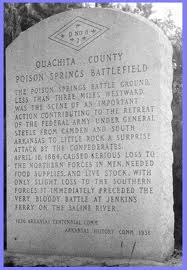 Racial Atrocity Southern Style was a Confederate War Crime perpetrated in Poison Springs, Arkansas on April 18, 1864. Many of the African-American Union soldiers engaged at Poison Springs were former slaves from Indian Territory and among the Confederate soldiers that they confronted were former slave holding Native-Americans from the Choctaw Nation.The Choctaws along with the other tribes from the Trail of Tears, were also owners of African Slaves and this was the first major battle in which former slaves from these tribes would meet former slave holding Confederate Native-American regiments. More racial tensions, than just white on black, added to the murder and mayhem in Southern Arkansas that day.
Racial Atrocity Southern Style was a Confederate War Crime perpetrated in Poison Springs, Arkansas on April 18, 1864. Many of the African-American Union soldiers engaged at Poison Springs were former slaves from Indian Territory and among the Confederate soldiers that they confronted were former slave holding Native-Americans from the Choctaw Nation.The Choctaws along with the other tribes from the Trail of Tears, were also owners of African Slaves and this was the first major battle in which former slaves from these tribes would meet former slave holding Confederate Native-American regiments. More racial tensions, than just white on black, added to the murder and mayhem in Southern Arkansas that day.
Union General Frederick Steele occupied Camden, Arkansas, in April of 1864. Two days later, he sent Colonel John Williams and 1,100 of his 14,000-man force to gather 5,000 bushels of corn discovered west of Camden. The force arrived to find that Confederate marauders had destroyed half of the store, but the Yankees loaded the rest into some 200 wagons and prepared to return to Camden. On the way back, 3,600 Confederates ambushed the Union wagons. General John Marmaduke was placed in command of the Confederate attack that ensued. Williams positioned part of his force, the 1st Kansas Colored Infantry, between the wagon train and the Confederate lines.
The determined soldiers of the 1st Kansas stopped the first two Rebel attacks, but they were running low on ammunition. The Confederate forces were joined by the Choctaw Brigade, a Confederate unit led by tribal leader Tandy Walker, forcing the Union soldiers into retreat. A third assault overwhelmed the Kansans, and the rout was on, Williams gathered the remnants of his force and fled, abandoning the wagons. Rebel troops followed Williams for two and one-half miles before calling off the pursuit. The Southern troops then turned their attention to the wounded and captured soldiers of the First Kansas and the racial atrocity began.
Williams lost 301 men killed, wounded and missing at Poison Springs. Of those, 117 of the dead and sixty-five of the wounded were from the First Kansas Colored Infantry. Rebel losses were incompletely recorded, but are believed to be fewer than 145. Several Union survivors claimed they saw their victorious foes killing black prisoners, including men too badly injured to get away, which accounted for the fact that the 1st Kansas had nearly twice as many personnel killed as wounded, an unusual occurrence in Civil War combat. No black troops were captured, and those left wounded on the battlefield were brutally killed, scalped and stripped.
Confederate participants confirmed the racial atrocity stories. “The havoc among the negroes had been tremendous,” a Texas officer confided to his journal. “Over a small portion of the field we saw at least 40 dead bodies. . ., some scalped & nearly all stripped. . . . No black prisoners were taken.” The editor of the Washington Telegraph, the mouthpiece of Confederate Arkansas, justified such merciless behavior in these terms: “We cannot treat negroes . . . as prisoners of war without a destruction of the social system for which we contend. . . . We must claim the full control of all negroes who may fall into our hands, to punish with death, or any other penalty.”
News of the Poison Spring Massacre soon reached Major General Frederick Steele’s 13,000-man Union army at Camden, twelve miles to the east. Colonel Samuel J. Crawford and the officers of the 2nd Kansas Colored Infantry grimly vowed “that in future the regiment would take no prisoners so long as the Rebels continued to murder our men.”
For the remainder of the Civil War, Remember Poison Springs, would become the battle cry of African-American soldiers.
The Racial Atrocity Southern Style, at Poison Springs, Arkansas, was not just a Confederate War Crime, but a poignant reminder of the hate that divided the country during the Civil War.
Bummer


I’ve long heard stories about how freed black troops and their white officers were told to expect no quarter from Confederates even when they surrendered but this sounds much worse. Never fails to amaze how war uncivilizes so many participants.
Louis,
Really don’t have the stomach to discuss these events often, however folks often forget what happened and where and why man reverts to barbaric ways. Guess that’s why they call it war.
Bummer